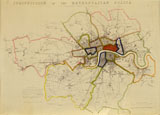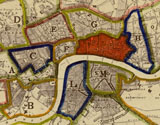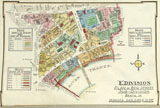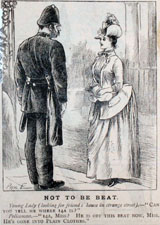Jurisdiction of the Metropolitan Police

Area of Metropolitan Police

Central area
The Metropolitan Police District (MPD) expanded throughout the nineteenth century as urbanization increased the size of London. By the 1920s the area of the County of London accounted for around one-sixth of the MPD. At that time, the MPD comprised two counties (London and Middlesex), parts of four other counties (Essex, Hertfordshire, Kent and Surrey), and 42 boroughs (including three county boroughs – Croydon, East Ham and West Ham). The vast size of London was often used to counter demands for local control (see below), demands voiced increasingly after the formation of the London County Council in 1888.
Specific orders as to the function of the police were formulated at Scotland Yard at the Office of the Commissioner. Police orders were read out when officers paraded prior to going on duty. Yet to understand policing in practice we need to examine the local unit of policing, the division. As the 1837 map shows, the Metropolitan Police District is divided into a number of territories known as divisions. These divisions vary in size from quite small patches in the heavily populated central areas, to large tracts of land in the less populated suburbs. According to the Commissioner's Report for 1875 the size of divisions varied from 0.79 to 84.69 square miles (St James and Hampstead respectively) with a total authorised strength of 9,553. By 1935 the authorised strength had increased to 19,364 and, after some boundary chages, with divisional areas now varying between 1.18 and 86.81 square miles (St James and Hampstead respectively).
This evidence tends to substantiate the common complaint voiced that there was 'one law for the rich, another for the poor'. Some complained that the police protected wealthy areas while neglecting poorer ones. It can be seen that divisions in predominantly working-class districts had fewer officers. Divisions such as 'E' Division, which had a mixed-class population, containing the elegant West End alongside very poor districts such as St. Giles, were policed heavily. It is possible, though no direct evidence has been found, that officers may have been concentrated more heavily in areas that bordered lower and middle-class districts. As you can see, in inner London divisions such as 'G', 'H' and 'L', which had a large working-class population, were policed less intensively.
A superintendent was in overall control of a division; each one was divided into a number of sub-divisions, the day-to-day affairs of which were run by an inspector. In turn each sub-division was divided into beats. As we will see in the module on Public Order, the role of the police in preventing and detecting crime and, more importantly, maintaining public order, meant for a heavy police presence on the streets of London. The survival of a few beat books gives an example of how the streets were policed. The saturation policy implicit in beat policing appears to have been predicated on maintaining public order.

Bow Street sub-division

No 1 Beat
By 1932 the area shown as F on the 1837 map above had been absorbed into 'E' (Holborn) Division and was now known as Bow-Street sub-division (left). It can be seen that the district was divided into 17 beats. Each beat, which was described in detail with its own plan, was patrolled during each of the three 8-hour shifts, commencing at 6 am, 2 pm and 10 pm. In turn, a number of interlocking patrols (including by this time the Women Police) covered the district: In the example of No 1 Beat shown alongside, two constables starting at Seven Dials (points A and B) patrolled the beat in opposite directions; at the same time two constables patrolled the beat starting at points C and D, the junction of Broad Street and Endell Street. The idea was that there would always be a policeman to hand within a 15-minute walk. Beat policing was a specific form of surveillance bounded by time and space. But as this cartoon from Fun (16 September 1886) shows, some believed that the beat police constable spent too much time cultivating friendships with young ladies - especially cooks and housemaids who might provide him with meals.

As we shall see in the following two modules (Public Order and Crime), social control, rather than crime control, was central to policing. The police got to know their patches intimately. They also took the time to make sure that all premises were secured properly.
As we saw in module two (Policeman as Worker), the pattern of strict beats also meant that constables could be tracked easily by patrolling sergeants. Again as we saw in module two, men from outside London were favoured as recruits in the Metropolitan Police since there were concerns about over familiar relations between the police and public.
 PC giving directions to a mono-cyclist, Hammersmith, c.1935.
PC giving directions to a mono-cyclist, Hammersmith, c.1935.